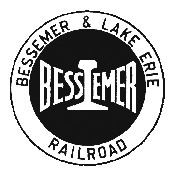Reporting mark BLE Dates of operation 1869– Website www.cn.ca Date of operation 1869 | Headquarters Homewood, IL Founded 1897 | |
 | ||
Track gauge 4 ft 8 ⁄2 in (1,435 mm) standard gauge | ||
Tunnelmotors and ore trains the bessemer and lake erie railroad
The Bessemer and Lake Erie Railroad (reporting mark BLE) is a class II railroad that operates in northwestern Pennsylvania and northeastern Ohio.
Contents
- Tunnelmotors and ore trains the bessemer and lake erie railroad
- Bessemer and lake erie railroad action 1996 through 2003
- History
- Locomotives
- References
The railroad's main route runs from the Lake Erie port of Conneaut, Ohio to the Pittsburgh suburb of Penn Hills, Pennsylvania, a distance of 139 miles (224 km). The original rail ancestor of the B&LE, the Shenango and Allegheny Railroad, began operation in October 1869.
Rail operations were maintained continuously by various corporate descendants on the growing system that ultimately became the B&LE in 1900. In 2004 the B&LE came under the ownership of the Canadian National Railway as part of CN's larger purchase of holding company Great Lakes Transportation. As a subsidiary of CN the B&LE has been largely unchanged (though repainting of B&LE locomotives into CN paint with "BLE" sub-lettering began in April 2015) and still does business as the B&LE. Bessemer and Lake Erie's locomotives, especially the former Souther Pacific SD40T-3 "Tunnel Motors", have been scattered across the CN system lately; ironically, many are being used in the line that feeds most of B&LE's traffic, the former Duluth, Missabe, and Iron Range lines in Minnesota. The iron ore that originates on these lines is transloaded to ships at Twin Harbors, Minnesota, then sent by ship to Conneaut, Ohio, where it is again transloaded to B&LE trains. It is then taken down to steel mills in the Pittsburgh area, mainly to the blast furnaces at US Steel's Edgar Thomson Plant in Braddock, Pennsylvania, part of the Mon Valley Works. As of summer 2015, most of the locomotives on the B&LE are former Illinois Central standard cab SD70's, although B&LE Tunnel Motor 905 and a few SD38's, still in B&LE orange, are being kept on the line. Also, a few Canadian National locomotives, especially SD60 5422, are assigned to the line.
Bessemer and lake erie railroad action 1996 through 2003
History
The Pittsburgh, Bessemer and Lake Erie Railroad Company was founded in 1897 by Andrew Carnegie to haul iron ore and other products from the port at Conneaut, Ohio on the Great Lakes to Carnegie Steel Company plants in Pittsburgh and the surrounding region. On the return trip, Pennsylvania coal was hauled north to Conneaut Harbor. The company was created largely out of a series of small predecessor companies including the Pittsburgh, Shenango and Lake Erie Railroad, and the Butler and Pittsburgh Railroad Company. The company was renamed the Bessemer and Lake Erie Railroad in 1900. Carnegie Steel had an exclusive 999-year lease to the PS&LE. This lease was acquired by US Steel when that company acquired Carnegie Steel in 1901.
At the end of 1925 B&LE operated 228 miles of road on 631 miles of track; at the end of 1970 mileages were 220 and 489.
In 1988 the Bessemer & Lake Erie Railroad became part of Transtar, Inc., a privately held transportation holding company with principal operations in railroad freight transportation, dock operations, Great Lakes shipping, and inland river barging that were formerly subsidiaries of USX, the holding company that owns U.S. Steel. In 2001 the Bessemer & Lake Erie Railroad became part of Great Lakes Transportation, LLC. On May 10, 2004 Canadian National Railway acquired the Bessemer and Lake Erie Railroad. Iron ore and coal are still the route's major freight commodities.
Locomotives
In the steam era, B&LE had a fleet of 2-8-0 "Consolidation" types, classes C1 through C4; 2-10-2 "Santa Fe" types, classes D1 and D2; and 2-10-4 "Texas" type locomotives, class H1. It also had a number of switchers, including 0-6-0s and 0-8-0s. The road dieselized in 1953. In the diesel era, B&LE's motive power has always been mostly Electro-Motive Division. It dieselized with many EMD F-units, which were supplemented by SD9s, SD18s and ALCo RSD15s. Later, it bought a number of EMD SD38ACs and SD38-2s to replace the F-units. In the late 1990s, it bought many EMD SD40T-3 "Tunnel Motors" from Southern Pacific Railroad to replace the 1950s-vintage SD9s. These units have been scattered under CN ownership in recent years. As a subsidiary of CN, the B&LE has been largely unchanged (though repainting of B&LE locomotives into CN paint with "BLE" sub-lettering began in April 2015). Bessemer and Lake Erie's locomotives, especially the SD40T-3 "Tunnel Motors," have been scattered across the CN system lately; ironically, many are being used in the line that feeds most of B&LE's traffic, the former Duluth, Missabe, and Iron Range lines in Minnesota. The iron ore that originates on these lines is transloaded to ships at Two Harbors, Minnesota; then sent by ship to Conneaut, Ohio, where it is again transloaded to B&LE trains. It is then taken down to steel mills in the Pittsburgh area, mainly to the blast furnaces at US Steel's Edgar Thomson Plant in Braddock, Pennsylvania, part of the Mon Valley Works. As of summer 2015, most of the locomotives on the B&LE are former Illinois Central standard cab SD70's, although B&LE Tunnel Motor 905 and a few SD38's, still in B&LE orange, are being kept on the line. Also, a few Canadian National locomotives, especially SD60 5422, are assigned to the line.
